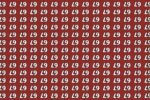Join on WhatsApp
Get the latest updates directly on WhatsApp – motivation, news & more!
Optical illusions have fascinated humans for centuries. They reveal how our brains interpret visual information and how easily perception can be tricked. One of the most interesting aspects of optical illusions is how they challenge our attention to detail. Some illusions are simple and playful, while others require a deeper focus to decipher hidden elements. The exercise of spotting hidden numbers among similar figures is a perfect example of this phenomenon.
The Challenge of Finding Hidden Numbers
Imagine a grid filled with a single number, like 65, repeated multiple times. Among them, there is one or two numbers that are inverted or flipped, such as 95 or a reversed 65. The task is simple to state but surprisingly difficult to execute in just six seconds. This type of optical illusion is not just a game; it is a test of visual perception, focus, and speed of cognitive processing.
Why Our Eyes Can Be Tricked
The human brain processes visual information in two primary ways: through pattern recognition and by focusing on anomalies. When we see repeated patterns, our brains tend to skim over them quickly, filtering out what seems familiar. This filtering process allows us to focus on new or unusual stimuli in our environment. However, this same process can make it difficult to spot something that is slightly different from the norm.
When presented with a grid of identical numbers, the brain assumes uniformity and often misses the subtle differences. Only by slowing down and training our eyes to look for irregularities can we spot the hidden inverted numbers. This is why many people struggle with the challenge if they try to complete it too quickly.
The Psychology Behind Quick Detection
Psychologists explain that tasks like these tap into selective attention. Selective attention is the brain’s ability to focus on a particular object while ignoring other stimuli. It is a skill that can be improved with practice. People who are skilled at noticing small differences in visual patterns often excel in fields like proofreading, coding, and quality control.
Moreover, the pressure of a time limit, like six seconds, introduces another psychological element: stress. Even a small amount of stress can cause the brain to overlook details that would otherwise be noticed under calm conditions. This is why timed visual challenges are both exciting and frustrating.
How to Improve Your Speed and Accuracy
There are several techniques you can use to enhance your ability to detect hidden numbers quickly. First, start by scanning the image in sections rather than looking at it as a whole. Breaking down the visual field into smaller chunks helps your brain process information more efficiently.
Second, try to focus on the shape rather than the number itself. An inverted number like 95 has a distinct visual shape that differs from 65. By training your brain to recognize shapes instead of numerical values, you can improve detection speed.
Third, practice regularly. Like any skill, visual perception can be strengthened with consistent exercises. Start with slower tasks and gradually decrease the time allowed to find hidden items. Over time, your brain becomes better at noticing subtle irregularities without conscious effort.
Fun and Benefits of Visual Puzzles
Optical illusions and hidden number challenges are not only entertaining but also beneficial for cognitive development. They improve concentration, memory, and problem-solving skills. They encourage mental flexibility and help the brain adapt to unexpected situations.
Additionally, these exercises are great for reducing stress. Engaging in focused, playful challenges allows the mind to shift away from daily worries and into a state of flow. This combination of relaxation and mental stimulation makes visual puzzles a perfect activity for all age groups.
The Appeal of “65s and 95s” Illusions
Why do illusions like the inverted 65 and 95 capture so much attention online? Part of the appeal lies in their simplicity. At first glance, the task seems easy, but the challenge emerges under a time constraint. People love testing themselves and sharing the results with friends, turning the illusion into a social game.
The challenge also sparks curiosity about how perception works. It encourages people to question their assumptions, such as whether they are really seeing what they think they see. This self-reflective aspect adds a layer of depth to what might otherwise be dismissed as a simple game.
Making It More Engaging
To make the illusion more engaging, creators often use a mix of techniques. Slight variations in font size, spacing, or orientation can increase difficulty. Some versions of the challenge include multiple inverted numbers, forcing the viewer to decide whether to focus on speed or accuracy. This balance keeps the mind actively engaged and prevents the exercise from becoming monotonous.
Tips for Success
When attempting to find hidden numbers, start by relaxing your eyes. Tension makes it harder to detect subtle differences. Use a systematic approach, scanning row by row or column by column. Don’t get discouraged if you don’t spot the inverted numbers immediately. Even experts need practice to improve their speed under strict time limits.
Another helpful tip is to view the image from a slight distance. Stepping back allows the overall pattern to emerge, making anomalies more noticeable. Some people find that tilting their head slightly can also help the brain perceive shapes differently.
Conclusion
Optical illusions like the “inverted 65 and 95” challenge are more than just visual games. They provide insight into how the brain processes patterns, handles anomalies, and reacts under pressure. By practicing these exercises, you can sharpen your visual perception, improve attention to detail, and enjoy a fun mental workout.
Whether you approach it as a game, a cognitive exercise, or a test of patience, the illusion reminds us that our perception is not always perfect. Sometimes, what we see depends not just on the eyes, but on how the brain chooses to interpret the world. With practice and focus, even the most subtle hidden numbers can be revealed, proving that the mind is capable of far more than we often realize.



